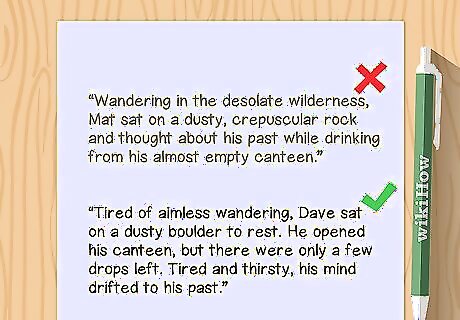
views
Brainstorming Ideas for Your Narrative

Make a list of meaningful topics. Write down a few topics that you care about enough to develop into a story. Think of experiences that resonated with you or left a lasting impact, such as a childhood event, a goal you achieved, or a mistake you made. The seed of your narrative doesn’t necessarily have to be a major life event. Even simple, often overlooked experiences, such as cooking a meal for a loved one or a chance encounter, can be packed with meaning. If you can’t think of a specific event to write about, try to find a small moment, memory, or image that stands out to you.Curiosity is key: Great questions yield compelling stories, so ask questions instead of taking your experiences at face value. For instance, find out why the elderly man who walks by your house in the morning carries a stick. His story could inspire you to write an entire narrative.

Write freely for at least 15 minutes a day. Without editing or monitoring yourself, write whatever comes to your mind for at least 15 minutes. Set a timer, sit in a quiet, distraction-free place, and write. After the 15 minutes is up, read what you wrote, and underline passages that you could further develop for your story. Don’t worry if you can't use a lot of the material. Free-writing is an exercise, and you’re probably not going to produce an incredible story right off the bat. When you free-write, you may come up with 1 or 2 fledgling ideas that are worth exploring, so don’t get discouraged. Some people also find it helpful to chat with a friend about a topic or an idea. If you have a thought you want to develop, try bouncing ideas off of a trusted, creative friend.

Practice writing descriptions with as much detail as possible. Take in the world around you using all of your senses. Observe a nearby object and write about it as vividly as you can. Describe its color, its shape, the way light strikes it, its smell, its texture, and the feelings it conjures within you. Think about how to conjure up a clear and vivid image in the minds of your readers. A vivid description could be, “Hand-painted, cheerfully swirling floral patterns on the grandfather clock's face had long ago begun to fade. Nicks and scratches in its tawny wooden body further evidenced its age. Wear and tear aside, one could only marvel at its precisely dovetailed joints and exquisitely sculpted split pediment top.” Carry a notebook (or use a memo app on your phone) and practice writing vivid descriptions throughout the day. To broaden your vocabulary, plug words into a thesaurus. Look up the definitions of the synonyms it generates, and use them when you practice writing descriptions in the future. Vivid details are essential to crafting a narrative, so practicing descriptive writing is time well spent. You may also be able to work a description of a coffee cup, chirping bird, or passerby into your narrative.

Choose a theme or message for your narrative. A narrative needs a point. Ask yourself, “What lesson do I want to offer my readers?” Think about what you learned from the experience that inspired your narrative. Be honest with yourself and your reader, and let your emotions drive your narrative’s message. Keep your message simple and clear. Building your narrative around a single, overarching message can help make it more memorable and impactful. If you’re writing about your own experiences, try to let yourself be vulnerable. It’s scary to write about emotions, whether they’re positive or negative, or to write with sincerity about a significant experience. Let that vulnerability fuel your narrative. For example, suppose you're writing about a breakup. Writing about how your actions contributed to the breakup isn't easy, even if you're recounting events with fictional characters. However, digging deep and being honest about what you did wrong will make your story more authentic.
Drafting Your Narrative

Set aside time to write every day. The blank page may seem daunting, but you have to start somewhere. You’ve brainstormed topics, honed your power of description, and thought of a compelling message. Now it’s time to sit down and write your story. Choose a distraction-free time and place and work on your story for at least 30 minutes a day. It’s okay if your words seem forced at first. As you write more, you’ll build the connection between your mind and hands, and engaging the keyboard or pen and paper will start to feel automatic. Note that doing free-writing exercises is different from writing your story. You can still write freely on any topic for 15 minutes a day, but set aside at least 30 minutes to write your story with focus.Tip: Try to get to know your work habits. Figure out when you’re most productive or creative. Some people thrive when they stick to a strict writing routine, while others are at their best when they wake up to write in the middle of the night.

Narrate your story with a consistent voice. Whether you’re crafting a first person nonfiction narrative or a third person work of fiction, keep your point of view and language consistent. Develop a clear idea of who your narrator is, why they’re telling the story, and what they have at stake. Even if you're writing a personal narrative from your own point of view, ask these questions of yourself. Keep in mind your narrator doesn’t need to be correct, truthful, or moral. An unreliable or immoral narrator can be an effective way to engage the reader. For instance, the narrator could have committed heinous crimes in the story, but wins the reader with their charm. The reader identifies with the narrator, and when they learn the extent of the narrator’s deeds, they examine their own morality.

Show the reader concrete details instead of summarizing events. Rather than list events, develop your settings and characters with specific, interesting details. Situate the reader in a specific place, and help them form a clear picture of your narrative’s world. Be descriptive, but try not to overwhelm the reader with details. Spelling out every breath a character takes or describing every speck of a room makes for tedious reading. Zero in on key details and, whenever possible, make them relevant to the story. For instance, suppose a character in your narrative is indecisive, and their inability to make decisions ultimately leads to your story’s climax. When you introduce the character, you could describe them struggling to make up their mind while ordering lunch, and that detail will foreshadow later events in the story.

Structure your narrative with a beginning, middle, and end. A coherent structure that builds up toward a climax or big moment is a defining characteristic of narratives. When you start putting your story together, sketch an outline of the events you’re describing. While it’s perfectly fine to employ devices like flashbacks, the concrete events of your story need to unfold in an organized manner. Organization is key whether you’re writing a journalistic narrative or a work of fiction. If you’re writing a personal narrative for an application or other professional purpose, it’s especially important that your organization is crystal clear. If you’re writing a creative piece, you have more room to experiment with structure. For instance, the plot may center on a character who’s struggling to reconstruct forgotten past events. Even if you play with the timeline, your story itself still needs a coherent plot that builds toward a big moment, revelation, or climax.

Build the story toward a climax or pivotal moment. A climax is a story’s most intense point. Typically, a narrative builds a conflict up to the climax, then concludes by resolving the conflict. Keep your theme or message in mind, and steer the plot toward your narrative’s pivotal moment. Be aware of your pacing. If your writing doesn’t hold your interest, it won’t keep the reader’s attention. Take time to provide key details and allow the plot to unfold, but get to the point instead of unnecessarily dragging out the story.
Revising Your Work

Refine your language so it’s as clear and concise as possible. Ensure your word choices are specific, concise, and clear. Look for opportunities to swap vague words for stronger, more precise alternatives. Break out your thesaurus and dictionary, and find crisp replacements for wordy phrases. For instance, “His sleeplessness became part of his normal routine and, like an animal active at night, he found that the dark of night heightened his senses,” is wordy. “His insomnia became habitual; like a nocturnal animal, his senses grew sharper with light’s absence” is crisper.Take a break: After drafting your narrative, put it aside for a day or so. Revise it after taking a break from it so you can approach it with fresh eyes.

Look for spelling and grammatical errors. Proofread your work, correct any typos, and check your grammar carefully. When recounting events, it’s easy to mix up verb tenses. Underline or highlight your action words, and make sure their tense matches your narrative’s timeline. For instance, if you’ve written your narrative in the past tense, watch out for places where your narrator may have slipped into the present. Keep in mind characters can think or speak using a different tense than the narrator. For example, it’s grammatically correct to write, “Noelle skipped and spun blithely as she chanted, ‘Tom loves Sophie! He’s gonna marry her! Tom and Sophie sitting in a tree!’”

Make sure your sentences and paragraphs flow. Watch out for choppy or disorganized sentences and awkward transitions between sections of your narrative. Make sure one sentence leads logically to the next, and vary your sentence structures for a more pleasing sound. From a big-picture perspective, ensure your paragraphs recount events logically. For instance, you might lose the reader if you start to detail one setting, digress for 3 paragraphs to discuss events in another location, bring up something completely unrelated, then finally finish describing the original setting.

Get feedback from your peers and mentors. Letting other people read your work can be intimidating, especially if you’re recounting personal experiences. However, it’s crucial to get a fresh perspective on your writing. Ask friends, relatives, and teachers to read your work and offer notes. If you’re writing about a personal experience, have someone who wasn’t present for the event read your narrative. They can give you an unbiased opinion about how well you make the experience real for them. If someone gives you tough notes on your narrative, try not to take it personally. Use their feedback to make your story stronger.




















Comments
0 comment